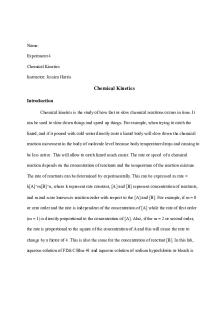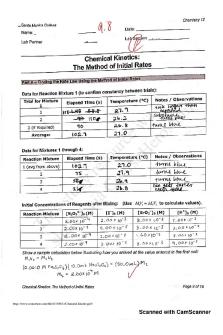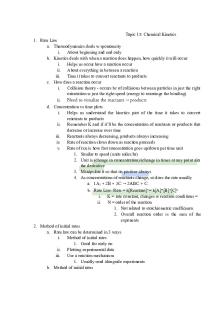Lab 11 Chemical Kinetics Report PDF

| Title | Lab 11 Chemical Kinetics Report |
|---|---|
| Author | Katrina Ting |
| Course | Physical And Organic Chemistry |
| Institution | The University of British Columbia |
| Pages | 4 |
| File Size | 158.5 KB |
| File Type | |
| Total Downloads | 80 |
| Total Views | 751 |
Summary
Katrina Ting #27308 CHEM 123 – LExperiment 11-Chemical Kinetics: Bleaching of DyesAbstract:The rate law for the reaction of food dye (Blue #1) and bleach (NaOCl) was analyzed using a spectrophotometer to produce kinetic traces. Both the food dye and the NaOCl were found to be the first order. The re...
Description
Katrina Ting #27308
CHEM 123 – L07
Experiment 11-Chemical Kinetics: Bleaching of Dyes Abstract: The rate law for the reaction of food dye (Blue #1) and bleach (NaOCl) was analyzed using a spectrophotometer to produce kinetic traces. Both the food dye and the NaOCl were found to be the first order. The reaction constant, k, was found to be 0.2868 M −1 s−1 for 0.40 M NaOCl and 0.2575 M −1 s−1 for 0.80 M NaOCl. Introduction: Blue #1 is a commonly used food dye and can be found in beverages, jellies and more (IACM 2020). Past studies were conducted to monitor Blue #1’s reaction rate with NaOCl. Blue #1 can be easily measure with the use of commercial visible light spectrophotometers (Ganley 2015). Its order can be determined by setting the bleach concentration to be much greater so that a pseudo rate constant, k’=k[bleach], can be used. In this study, the rate law of the reaction bleach with dye has been determined. The research has been conducted to determine whether the bleach and the dye are first order reactions. This can be seen if the graph of ln (Absorbance) vs. time shows a linear slope and if k’ doubles when the concentration of bleach doubles. Method: The rate law and reaction rate of bleach and dye were studied. The reaction order of the dye was measured with a bleach content that was much greater using a kinetic trace produced by a spectrophotometer. Then the reaction order of the bleach was measured by producing another kinetic trace with a different concentration of bleach, becoming the measured variables. The dye concentration and the volume (of the dye and the bleach) were kept constant, becoming the controlled variables. The original concentration of the dye used was 8.0× 10−6 and the original concentration of the bleach was 0.40 M and 0.80 M. 9.0 mL of dye was transferred to a vial and was placed into a spectrophotometer. The black lid was put on as soon as 1.0 mL of 0.40 M bleach was added. The spectrophotometer was stopped once 0.20 Abs was reached. The kinetic trace was monitored and the graph of ln (Absorbance) vs. time was plotted. The k’ (slope) of the linear line was recorded and this process was repeated 5 times for a total of 6 trials. This was repeated with 1.0 mL of 0.80 M bleach for 6 trials as well. The Beer’s law calibration plot was plotted by diluting the dye with deionized water for concentrations of 20%, 40%, 60%, 80% and 100% for a total volume of 10 mL. Results: [Bleach] (M) 0.40 0.80
Initial [Bleach] (M) Average k’ ( s−1 ) 0.040 0.01147 0.080 0.02060
k value ( M −1 s−1 ) 0.2868 0.2575
Class average k ( −1 −1 M s )
0.3517 0.3164
Table 1: Concentration of Bleach, pseudo rate constant k’, and rate constant k
The rate constant, k, for both the 0.40 M and 0.80 M bleach had similar k values with a difference of 0.0293 M −1 s−1 . Both k values were lower than the class average k values. As the bleach concentration doubled (0.40 M vs. 0.80 M) so did the k’ value (0.01147 s−1 vs. 0.02060 s−1 ¿ . Discussion: The kinetic traces of dye and bleach (at 2 different concentrations, 0.40 M and 0.80 M) were plotted in order to determine the order and rate law. The value of k’ was experimentally determined to be 0.01147 s−1 for 0.40 M and 0.02060 s−1 for 0.80 M. The rate constant, k, was determined to be 0.2868 M −1 s−1 for 0.40 M and 0.2575 M −1 s−1 for 0.80 M. According to the kinetic trace (attached), when the graph of ln (Absorbance) vs. time is plotted, a negative linear slope is shown, regardless of the concentration of the bleach. Due to this, the reaction order of the dye and the bleach is established to be a first order (as the graph fits the |¿ 0| equation: ln [Abs] = -k’t + ln [ ], mimicking y = mx+b). Because k’ is a pseudo rate ¿ constant, we can use the equation k’ = k[bleach] and as bleach is a first order reaction, as shown in Table 1, when the concentration of bleach is doubled, so is the k’ value. The findings support the hypothesis. The graph of Absorbance vs. time can be used to produce kinetic traces because it has a correlation to concentration which is stated in Beer’s law equation: A=ϵcl. This helps to convert absorbance into concentration. According to the Abs vs. time graph of 9.0 mL of 8.0× 10−6 dye and 1.0 mL of 0.80 M bleach, Abs=0.60 when time is 40 seconds. At 70 seconds, Abs=0.30. When time is 40 seconds, −8 moles the instantaneous reaction rate is 4.17× 10 . At t=70 seconds, the rate is 2.09× Ls −8 moles 10 which is half of the former. This occurs because of the equation rate=k’[dye]; Ls meaning that when dye concentration doubles, the rate does as well. According to Table 1, the k value for 0.40 M and 0.80 M bleach are lower than the class average by 0.0649 and 0.0612 respectively. This may be due errors in the experiment. For the graph of Absorbance vs. time, there were many points off the linear curve fit meaning that the dye was either over diluted or too concentrated then desired. This could be due to the limitations of the measuring device for bleach, a syringe. This could lead to an inconsistent amount of bleach being added to the dye leading to a slightly faster or slower reaction. This error could be fixed by replacing the syringe with a serological pipet. For further experimentation, the effect of NaOCl on different types of food dye could be explored. Conclusion:
The dye and the bleach are the first order. The rate constant for 0.40 M bleach is 0.2868 while the rate constant for 0.80 M bleach is 0.2575 M −1 s−1 . Hypothesis is M s supported. −1 −1
References: Ganley, J.C. Educ. Chem. Eng. 2015, vol.12, p.20-26 IACM. Brilliant Blue FCF. https://iacmcolor.org/color-profile/brilliant-blue-fcf-fdc-blue-no-1/ (accessed March 6, 2020)
Appendix:
Ganley, J.C. Educ. Chem. Eng. 2015, 12, 20. IACM. Brilliant Blue FCF. https://www.iacmcolor.org/safet y-of-color/safety-syntheticcertified-colors/blue-1/
(accessed March 11, 2019) Ganley, J.C. Educ. Chem. Eng. 2015, 12, 20. IACM. Brilliant Blue FCF. https://www.iacmcolor.org/safet y-of-color/safety-synthetic-
certified-colors/blue-1/
(accessed March 11, 2019) Initial Concentration for 0.40 M Bleach: 0.40 M×
1.0 mL 10 mL
= 0.040 M
Initial Concentration for 0.80 M Bleach: 0.80 M×
1.0 mL 10 mL
= 0.080 M
Rate constant, k, for 0.40 M Bleach:
k' 0.01147 s−1 = [ Bleach ] 0.040 M
= 0.2868 M −1 s−1
Rate constant, k, for 0.80 M Bleach:
k' 0.02060 s−1 = [ Bleach ] 0.0 8 0 M
= 0.2575
M −1 s−1
Class Average k value for 0.40 M: ( 0.2652 + 0.3060 + 0.2868 + 0.3288+ 0.2914 + 0.2375 + 0.5313+ 1.284 + 0.2369 + 0.3200 + 0.3120 + 0.2475 + 0.277 +0.3880+0.3481+0.2560+0.2863+0.3481)/22 = 0.3517 Class Average k value for 0.80 M: 0.2441 + 0.3210 + 0.2575 + 0.3463 + 0.3275 + 0.2730 + 0.5338 + 0.3288 + 0.2950 + 0.3463 + 0.3050 + 0.2875 + 0.305 ¿ )/22 = 0.3164 Beer’s Law Plot Slope = 0.0132
%
−1
= 0.0132
%
−1
×
100 % 8.0 × 10−6
= 1.65× 105
M −1 Instantaneous Reaction Rate at 40 seconds: ( 10−8
moles Ls
Instantaneous Reaction Rate at 70 seconds: ( 10−8
0.60 5 ) × 0.01147 = 4.17× 1.65 ×10
moles Ls
0. 3 0 ) × 0.01147 = 2.09× 1.65 ×10 5...
Similar Free PDFs

Lab 11 Chemical Kinetics Report
- 4 Pages

Chemical Kinetics - lab report
- 4 Pages

Chemical Kinetics lab
- 9 Pages

Enzyme Kinetics Lab Report
- 14 Pages

Kinetics Lab Report
- 8 Pages

Lab Report - Enzyme Kinetics
- 4 Pages

Topic 15 Chemical Kinetics
- 5 Pages

Enzyme Kinetics 5 - Lab report
- 8 Pages

Chemical Kinetic Lab Report
- 2 Pages

Lab Report Chemical Composition
- 3 Pages

Chapter 14- Chemical Kinetics
- 3 Pages

Chemical Kinetics-DR. ASM
- 44 Pages
Popular Institutions
- Tinajero National High School - Annex
- Politeknik Caltex Riau
- Yokohama City University
- SGT University
- University of Al-Qadisiyah
- Divine Word College of Vigan
- Techniek College Rotterdam
- Universidade de Santiago
- Universiti Teknologi MARA Cawangan Johor Kampus Pasir Gudang
- Poltekkes Kemenkes Yogyakarta
- Baguio City National High School
- Colegio san marcos
- preparatoria uno
- Centro de Bachillerato Tecnológico Industrial y de Servicios No. 107
- Dalian Maritime University
- Quang Trung Secondary School
- Colegio Tecnológico en Informática
- Corporación Regional de Educación Superior
- Grupo CEDVA
- Dar Al Uloom University
- Centro de Estudios Preuniversitarios de la Universidad Nacional de Ingeniería
- 上智大学
- Aakash International School, Nuna Majara
- San Felipe Neri Catholic School
- Kang Chiao International School - New Taipei City
- Misamis Occidental National High School
- Institución Educativa Escuela Normal Juan Ladrilleros
- Kolehiyo ng Pantukan
- Batanes State College
- Instituto Continental
- Sekolah Menengah Kejuruan Kesehatan Kaltara (Tarakan)
- Colegio de La Inmaculada Concepcion - Cebu



